Fjords & Jazz: Explore Norway in 9 days
23rd of June 1998. I first set foot on Norway exactly 20 years ago. This was the day that Norway beat Brazil in the World Cup. It was also the day that the critically-acclaimed music video for Madonna’s ‘Ray of Light’, directed by the Swedish Jonas Åkerlund, was released on VHS only to become the best-selling video singles of the Nielsen SoundScan era. It was almost midnight when I first watched the iconic video on MTV, high-speed images of Madonna dancing, whilst Norwegians were celebrating all over Oslo. Outside, there was still daylight.
Madonna’s iconic ‘Ray of Light’ directed by Jonas Åkerlund.
20 years on, I am still a huge Madonna fan. But, I have also become a jazzophile. As such, I’ve wanted to explore Norway’s thriving jazz scene. Every year from May to August, when the days just don’t turn into nights, plenty of festivals take place across the country. These include AnJazz (Hamar, May), Bodø Jazz Open (Bodø, May), Maijazz (Stavanger, May), Trondheim Jazz Festival (Trondheim, May), Nattjazz (Bergen, May/June), Kongsberg Jazzfestival (Kongsberg, July), Moldejazz (Molde, July), Sildajazz (Haugesund, August), Tromsø Jazzfestival (Tromsø, August) and Oslo Jazzfestival (Oslo, August).
Norwegian quartet Rohey performing live at Rockefeller Music Hall in Oslo in 2017. They are due to play at Kongsberg Jazzfestival on the 4th and 5th of July 2018.
The 9-day itinerary I describe here is slightly different to the one I followed; it is the one I would have followed had I had the insight that I now have. I visited Norway during the Nattjazz Festival in late May/early June, but I have tweaked the itinerary so you could easily combine it with the Oslo Jazzfestival due in August. Start in Oslo and stay a night there. Then, fly to Ålesund and stay the second night there. On the third day, fly to Bergen and stay four nights there. On the seventh day, take the train back to Oslo and stay two more nights there (unless you don’t go to the Jazzfestival, in which case you could spend an extra night in another city).
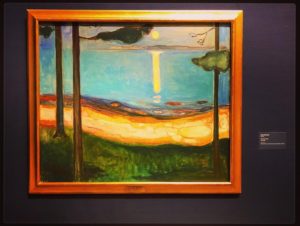
Day 1 (Saturday) – Oslo
To make the most of your first day as well as your holiday, take the earliest flight possible. British Airways and SAS fly from London Heathrow to Gardermoen airport. Norwegian flies from London Gatwick to Gardermoen, whereas Ryanair flies from London Stanstead to either Gardermoen or Torp. I took the SAS SK802 flight, which departed from London at 07.05 and landed in Oslo at 10.15. From the airport, take the regional (not the Flytoget) train to Oslo S (the capital’s main railway station) as it takes only 4 minutes more (23 minutes in total) but costs half the price (NKK 101 one-way). Once you arrive in Oslo, store your luggage in the train station (NKK 50) and start exploring the city.
Walk on Karl Johans gate, Oslo’s main street, past the Cathedral and then the Parliament. Continue straight ahead towards the Royal Palace, which you can see in the distance. On your left-hand side, there’s the Nationaltheatret (National Theatre); on your right, you can see the Scandinavian Institute of Maritime Law. The Nasjonalgalleriet (National Gallery) is on Universitetsgata – just a minute away. It houses Norway’s largest public collection of paintings, drawings and sculptures, including works by Norwegian painters Edvard Munch (‘Scream” being the most famous), J.C. Dahl and Thomas Fearnley. I would recommend spending 1 to 2 hours there. At the weekends, Nasjonalgalleriet opens at 11.00 at the weekends (10.00 on weekdays) and closes at 17.00 (18.00 on weekdays). It is closed on Mondays (admission NOK 120).
By this time, you may have already realized that Norway is one of the most expensive countries you’ve visited. Food and drinks are particularly pricey. But, if you want to have a light and relatively inexpensive meal (breakfast/brunch/lunch), there are several bakeries/cafés in the area. Since Norwegians are the 2nd biggest coffee drinkers in the world (after the Finns), it should come as no surprise that Oslo is heaven for coffee lovers, myself included. The average coffee drinker has almost four cups per day; I, therefore, suggest these four places to have yours: Kaffebrenneriet is a popular chain and one of my favourites (in particular the one on Universitetsgata opposite Nasjonalgalleriet). Other popular chains include W.B. Samson and Åpent bakeri; you can find them both on Karl Johans gate (some of their shops also serve pizza). Another favorite of mine is MESH on Tordenskiolds gate; the food and drinks bar in the backyard stays open till late serving coffee, light meals and cocktails.
In the evening, go to Blå, a music venue on Brenneriveien in Grünerløkka, where you can listen to indie, rock and jazz bands, or live DJ sets (NOK 120-350). Most concerts start at 19.00 or 20.00; however, on Sundays, the Frank Znort Quartet plays at 16.00 (free admission).
The Frank Znort Quartet performing ‘Too Drunk To Fuck’ live at Blå.
Day 2 (Sunday) – Oslo to Ålesund
If you’re staying in (or near) Grünerløkka, one of Oslo’s hippest areas, start your day with a coffee at Tim Wendelboe’s coffeeshop and roaster (Grünersgate 1), or at Java Espressobar & Kaffeforretning (Ullevålsveien 47). You can then visit the Munchmuseet on Tøyengata, home to more than half of Edvard Munch’s paintings (open every day 10.00-17.00, admission NOK 120). For a light lunch, go to Mathallen, a food court also in Grünerløkka, which is open till 20.00 every day except for Mondays (closed all day) and Sundays (open till 18.00).
From Oslo fly to Ålesund, a beautiful port town on the west coast. I took the Norwegian DY414 flight, which departed at 17.55 and landed 55 minutes later. From Vigra airport, take the bus to Ålesund; the fare is NOK 80 (one-way) and the journey takes roughly 25 minutes.
Have a Norwegian meal at Lyst on Kongens gate (I had ‘Bacalao a La Lyst’: cod in a tomato stew with vegetables and mashed potatoes, NOK 294), or at Lyspunktet on Kipervikgata (I had the fish soup, NOK 195). Finish off the day with a cocktail at Milk, a big-windowed bar at the seafront (I had the ‘Fjellbekk’: vodka, aquavit, lime cordial and sprite, NOK 114).
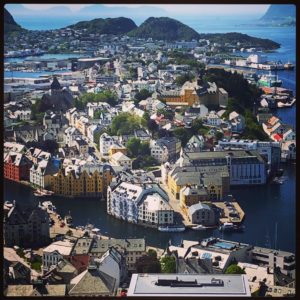
Day 3 (Monday) – Ålesund to Bergen
Start your day with coffee and a light breakfast at Racoon Coffee & More on Kongens gate. Go for a walk around the art nouveau town centre. Visit the Art Nouveau Centre (Jugendstilsenteret) and the Art Museum KUBE (Kunstmuseet) on Apotekergata (open every day from 10.00 to 17.00, Thursdays from 10.00 to 20.00, admission NOK 85). Jugendstilsenteret is located in an old pharmacy and is both a museum and a national centre of Art Nouveau, while KUBE is located in a former Bank of Norway building. Climb the 418 steps to Aksla and admire the spectacular view of the town, the surrounding mountains and the nearby islands.
From Ålesund fly to Bergen, Norway’s second-largest city located on the southwestern coast. The flight lasts for only 40 minutes. From the Flesland airport, take the train (45 minutes, NOK 35) or the bus to the city centre (30 minutes, NOK 105-125).
In Bergen, have a late dinner at Royal Gourmetburger & Gin on Neumanns gate, or at Pingvinen on Vaskerelven. Then go bar-hopping on Nygårdsgaten: Apollon, Garage, Legal, Don Pippo, or at Ujevnt on Christies gate.
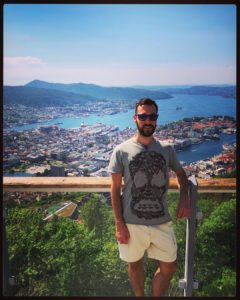
Day 4 (Tuesday) – Bergen
Begin your day with a coffee at one of these four cafés (remember that the average Norwegian drinks four cups of coffee a day): Det Lille Kaffe Kompaniet (on Nedre Fjellsmauet) and Kaffemisjonen (on Øvre Korskirkeallmenning) are located near the port, whereas Blom (on John Lunds plass) and Kaffebrenneri (on Thormøhlens Gate) are near the University.
Start your sightseeing by visiting the Fantoft Stavkirke (Fantoft Stave Church). From the city centre, take the Bergen Light Rail to Fantoft or Paradis; the church is a short walk from there (open every day 10:30-18.00, admission NOK 60). Once present in many parts of northern Europe, nowadays stave churches are almost exclusively found in Norway. This is one of the 28 still remaining in the country. Located in the Fana borough of Bergen, this elaborately carved wooden church was destroyed by arson in 1992, but has since been reconstructed.
Return to central Bergen. The most instagrammable sight is undoubtedly the colourful façade of Bryggen Hanseatic Wharf (also known as Tyskebryggen) by the Vågen harbour. Bryggen is now a UNESCO World Heritage site. Next to it is the outdoor Fish Market, where you can enjoy an open salmon or whale sandwich (NOK 60).
Surrounded by seven hills and seven fjords, Bergen is also known as the city of the Seven Mountains. Take the Fløibanen Funicular that goes 320m above sea level to the top of Fløyen Mountain, one of the seven mountains (the one-way ticket costs NOK 45). From there you can enjoy panoramic views of the city, the harbour and the fjords, and, if the weather allows, follow the hiking trails, or simply walk downhill back to the city centre.
One of the largest jazz festivals in Norway is Bergen International Jazz Festival (also known as Nattjazz), which is held annually in late May/early June and takes place in a beautiful central location. Doors open at 19.00 or 20.00 except for Sunday (18:30); so you can combine it with sightseeing, or with a day trip to the fjords. Each evening there are up to 6 Norwegian or international bands or artists playing. In 2018 Nattjazz took place over 9 days (9-day pass NOK 2150, 5-day pass NOK 1350, 1-day-pass NOK 140-650). When the music stops (not before midnight), wander around in the twilight – it will soon turn into full daylight.
Thomas Dahl & Court performing live in Bergen in 2017. They also played at Nattjazz this year.
If you don’t visit during Nattjazz, check if there is a concert at the medieval Bergenhus Fortress.
Day 5 (Wednesday) – Bergen & fjords
Bergen is an ideal place to explore the fjords. Fjord Tours offer a wide range of options, including the popular ‘Norway in a Nutshell’ 10-hour round-trip, which was the one I chose. Take the 08.43 train to Myrdal, where you get on the Flåm Railway (Flåmsbana) embarking on one of the world’s most beautiful train journeys, as rightly advertised on the sides of the green train. This 20 km-long train ride offers spectacular views of ravines, waterfalls and mountains, and it also makes a short photo stop at the Kjosfossen waterfall. The 57-minute journey ends in Flåm, a tiny village located at the head of Aurlandsfjorden. Here you can stay for either one and a half or four hours before you take the ferry to Gudvangen. Or, if you want to make an overnight stop in Flåm, go hiking and further explore the beautiful fjord scenery, you can stay at the Fretheim Hotel and continue on the ferry the following day.
The 2-hour cruise on the Aurlandsfjord and then on the Nærøyfjord, the narrowest arm of Sognefjord, was simply the highlight of my 9-day trip. Together with the Geirangerfjord, the 17 km-long Nærøyfjord has been included in the UNESCO World Heritage List. The ferry will bring you to Gudvangen; from there, a bus will take you to Voss, where you get on the train back to Bergen. On your way to Voss, the bus will drive past the Stalheim Hotel, Norway’s most spectacularly sited hotel, then down Stalheimskleiva, one of the steepest roads in Northern Europe. Also passing between Sivlefossen and Stalheimsfossen waterfalls, the view is all the way magnificent.
As mentioned, ‘Norway in a Nutshell’ is available as a day tour starting from Bergen (and also from Oslo, Voss or Flåm), but can be extended with overnight stays en route (from NOK 1600). Other popular tours include ‘Hardangerfjord in a Nutshell’ (from NOK 1570) and the ‘Sognefjord in a Nutshell’ (from NOK 1750). Both can be either done as a round-trip from Bergen or a one-day trip from Oslo to Bergen and they can also be extended with overnights stays.
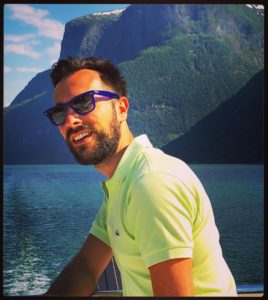
Day 6 (Thursday) – Bergen
Spend the day at the KODE Art Museums and Composers Homes (open every day 11.00-17.00, admission NOK 120). KODE 1, 2, 3 and 4 are located in the centre of the city and house permanent and temporary exhibitions of art, including works by Edvard Munch, J.C. Dahl and Nikolai Astrup. Three composers’ homes (Ole Bull Museum Lysøen, Harald Sæverud Museum Siljustøl and Edvard Grieg Museum Troldhaugen) are also part of KODE.
Start with a half-hour lunchtime concert in the Troldsalen chamber music hall at Troldhaugen, located right next to Edvard Grieg’s villa. Troldsalen is considered one of the most beautiful chamber music halls in Norway. The ticket costs NOK 160 and includes the concert and a guided tour through Edvard Grieg’s villa. To get there from the city centre, take the Light Rail to Hop.
Return to central Bergen to visit the KODE Art Museums on Rasmus Meyers allé. Combine your visit with a coffee or light lunch at Smakverket in KODE 2, dinner at Bien Centro in KODE 1, or a cocktail at Lysverket in KODE 4.
‘In the Hall of the Mountain King’ was composed by Norwegian composer Edvard Grief for Henrik Ibsen’s play ‘Peer Gynt’.
Day 7 (Friday) – Bergen to Oslo
Take the train from Bergen to Oslo, a distance of 496 kilometres. The journey, one of the world’s most scenic train rides, takes almost 7 hours. Crossing the Hardangervidda plateau at 1,237 metres above sea level, it is also the highest mainline railway line in Northern Europe. The first train departs at 07.57 and arrives to the capital at 14.45 (prices vary between NOK 249 and 1000 depending on when you buy the ticket).
The jewel in the crown of the Norwegian capital is undoubtedly the Opera House, an architectural masterpiece that has been standing tall by Oslofjord (Oslofjorden in Norwegian) since 2008. Wander around the building, then walk up onto the roof, and finally enter the foyer, which houses a café and a restaurant. Ticket prices for opera or ballet performances vary starting from as little as NOK 100. A new Munch Museum, due to open in 2020, is currently being built next to the Opera House.
Afterward, it’s probably time for another aquavit-based cocktail. In the city centre, there are lots of bars worth of a visit, including the rooftop Eight on the eighth floor of the Grand Hotel (Karl Johans gate 31), the famous Fuglen (Universitetsgata 2) and the speakeasy Himkok (Storgata 27). On a Saturday night, be prepared to queue. Alternatively, head to Grünerløkka. Bar Boca is one of the many cocktail bars in this hippy area.
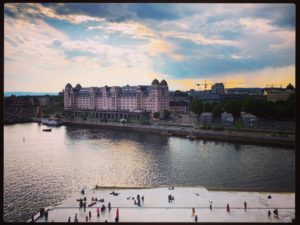
Day 8 (Saturday) – Oslo
Oslo Jazz Festival is held in August when the city enjoys 16 hours of daylight and 8 hours of twilight. This year it takes place between the 12th and the 18th of August and it features a large number of Norwegian and international bands and artists. There are several concerts each day from 18.00 till late; on Saturday the 18th of August, there are concerts from as early as 12.30. It takes place at various venues around the city: the Opera House, Oslo Konserthus (Concert House) (very close to the Royal Palace), Rockefeller Music Hall (also in the city centre), Nasjonal Jazzscene Victoria and Universitetets Aula (both on Karl Johans gate). You can buy day passes or tickets for individual concerts.
Norwegian band Beady Belle played Oslo Jazz Festival in 2017.
Day 9 (Sunday) – Oslo
Spend your last morning in Oslo at Frognerparken, also referred to as Vigelandsparken (Vigeland Sculpture Park). Here you can have a picnic or stroll around and admire the 212 bronze and granite sculptures by the Norwegian Gustav Vigeland. The sculptures consist of naked human figures, in various poses and situations. At the highest point lies the Monolith, the centrepiece of the park, composed of 121 human figures rising towards the sky. The park is a nice 25-minute walk from the Royal Palace. Walk on Colbjørnsens gate and then on Gyldenløves gate. On your way you will walk past two beautiful bakeries/cafés, Åpent bakeri (Inkognito Terrasse 1) and W.B. Samson (Gyldenløves gate 6). Mocca Kaffebar & Brenneri is also close by (Niels Juels gate 70). If you don’t want to walk back to the city centre, you can take the tram 12.
Head to Aker Brygge. Walk past the Nobel Peace Centre towards the pier and the boardwalk. This harbour is home to a number of restaurants, shops and galleries. From here, you can see the Akershus Fortress, a medieval castle standing tall on the other side of the bay, sometimes serving as a venue for music concerts. Or you can take a boat to the small Bygdøy peninsula. Past the boardwalk, there’s Tjuvholmen, a beach where the locals often enjoy in the summer.
To make the most of your last day in Norway, take an evening flight back home. I took the SAS SK815 flight, which departed from Oslo at 20.15 and landed in London at 21.35. Finally, if you’re flying from Gardermoen airport, look out for two original works by Edvard Munch. They’re on display towards the D gates in the International Departures section.
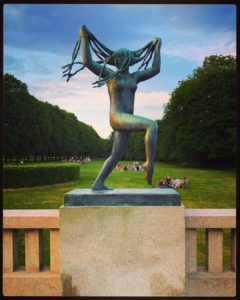
Accommodation
In Oslo, I stayed at Best Western Kampen and at Norwegian (Kjølberggata 29). These co-located hotels are within walking distance from the city centre and the train station, as well as Grünerløkka (no more than half an hour). Other (budget) options include the even more centrally-located Citybox (Prinsens gate 6) and the design PS: Hotell (Maridalsveien 13).
In Ålesund, I stayed at Norhostel Apartment (Parkgata 14); it is only 10 minutes walk from Skateflukaia, where the tourist office, the bus station and the ferry terminal are.
In Bergen, I stayed at Citybox (Nygårdsgaten 31). This modern hostel-hotel hybrid is located in the city centre and is very close both to the train station (8-minute walk) and to Bryggen (20-minute walk).
Further reading (on Norway and beyond)
To better prepare for my trip, I used the Lonely Planet Travel Guide.
To follow my travels around the world, simply subscribe to the Traveling Psychiatrist (just click on the menu on the left hand side).
God Tur1,
Alex
(the Traveling Psychiatrist)
1 Norwegian for ‘have a nice trip’
2 Comments
Pingback:
Pingback: